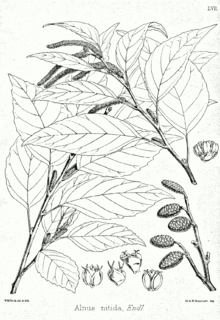Alnus nitida
| Alnus nitida | |
|---|---|

| |
| Botanical illustration | |
| Scientific classification | |
| Kingdom: | Plantae |
| Clade: | Tracheophytes |
| Clade: | Angiosperms |
| Clade: | Eudicots |
| Clade: | Rosids |
| Order: | Fagales |
| Family: | Betulaceae |
| Genus: | Alnus |
| Species: | A. nitida
|
| Binomial name | |
| Alnus nitida | |
| Synonyms[3] | |
|
Clethropsis nitida Spach | |
Alnus nitida, called the west Himalayan alder, is a species in the genus Alnus, native to Pakistan, the western Himalayas, and Nepal.[3] It is a tree reaching 20 to 25 m, preferring to live along the banks of rivers. It is used locally for timber and firewood, and as a street tree.[4] The bark is used in some places for tanning and dyeing purposes.[5] It grows well in heavy, clay soils and tolerates infertile soils.[6] The leaves are thin, oval to ovate, 3-6 inches long and 2-3 inches wide.[7] Female flowers appear first, followed by male catkins in September to October, which may be up to 19 centimeters long.[5] The fruits are woody cones, typically 2.5-3.5 cm long.[8]
This tree may be attacked by the apple stem borer (Trirachys holosericeus).[9]
In some places, the bark is used as an anti-inflammatory. One study examined its chemical components and concluded it has antioxidant potential.[10]
References
- ^ Shaw, K., Roy, S. & Wilson, B. (2014). "Alnus nitida". IUCN Red List of Threatened Species. 2014: e.T194659A2356455. doi:10.2305/IUCN.UK.2014-3.RLTS.T194659A2356455.en. Retrieved 3 May 2021.
{{cite journal}}: CS1 maint: multiple names: authors list (link) - ^ Gen. Pl., Suppl. 4(2): 20 (1847)
- ^ a b "Alnus nitida (Spach) Endl". Plants of the World Online. Board of Trustees of the Royal Botanic Gardens, Kew. 2017. Retrieved 21 December 2020.
- ^ Khan, Muhammad Khalil Ullah; Muhammad, Noor; Uddin, Nisar; Ali, Niaz; Umer, Muhammad; Ullah, Shariat (2020). "Genetic diversity in threatened plant species Alnus nitida (Spach.) Endel". Plant Science Today. 7 (3): 314–318. doi:10.14719/pst.2020.7.3.759.
- ^ a b "Alnus nitida in Flora of Pakistan @ efloras.org". www.efloras.org. Retrieved 2021-05-03.
- ^ "Alnus nitida - Useful Temperate Plants". temperate.theferns.info. Retrieved 2021-05-03.
- ^ "Alnus nitida - Trees and Shrubs Online". treesandshrubsonline.org. Retrieved 2021-05-03.
- ^ "Fact Sheet: Alnus nitida". idtools.org. Retrieved 2021-05-03.
- ^ "Alnus nitida (West Himalayan alder)". www.cabi.org. Retrieved 2021-05-03.
- ^ Sajid, Moniba; Khan, Muhammad Rashid; Shah, Naseer Ali; Shah, Sayed Afzal; Ismail, Hammad; Younis, Tahira; Zahra, Zartash (2016-08-03). "Phytochemical, antioxidant and hepatoprotective effects of Alnus nitida bark in carbon tetrachloride challenged Sprague Dawley rats". BMC Complementary and Alternative Medicine. 16 (1): 268. doi:10.1186/s12906-016-1245-3. ISSN 1472-6882. PMC 4972964. PMID 27488054.
{{cite journal}}: CS1 maint: PMC format (link) CS1 maint: unflagged free DOI (link)

